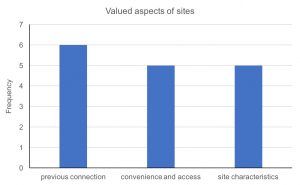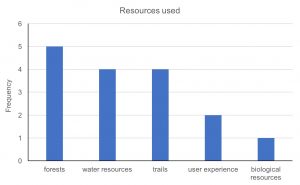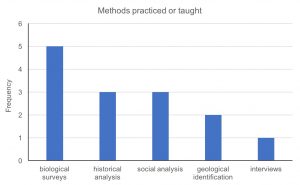Experiential Education
The Upper Valley contains untapped potential to heighten community engagement with the land. The Trescott Property, for instance, offers resources that could enhance the curricula of many Dartmouth courses. Although a variety of Dartmouth professors already augment teaching in the classroom with fieldwork, trips, and off-campus labs, few, if any, use the Trescott Property. The property is not particularly well known among faculty and has not been framed as a site for academic use. Those who know of it see it as a water source and recreation area, not as a place for study. By engaging professors with the property we could access the tri-fold benefits of promoting respectful multi-use, community engagement, and scientific insights provided to property managers.
 To investigate current faculty involvement with the Trescott Property and similar Upper Valley resources, we distributed a survey to targeted professors and lab coordinators. Faculty were selected for the survey based on known use of or potential interest in off-campus resources. Such faculty included professors in the Biological Sciences, Environmental Studies, Earth Sciences, Geography, History, Sociology, and Anthropology departments. Our results clarify faculty involvement with Upper Valley resources and attitude toward integrating the Trescott property into their curricula.
To investigate current faculty involvement with the Trescott Property and similar Upper Valley resources, we distributed a survey to targeted professors and lab coordinators. Faculty were selected for the survey based on known use of or potential interest in off-campus resources. Such faculty included professors in the Biological Sciences, Environmental Studies, Earth Sciences, Geography, History, Sociology, and Anthropology departments. Our results clarify faculty involvement with Upper Valley resources and attitude toward integrating the Trescott property into their curricula.
In our seven day data collection period, fourteen out of thirty eight recipients responded to the survey. Of the respondents, half currently involve fieldwork, labs, trips, or case studies in their curricula. Of these respondents, none use the Trescott Property as an educational resource. Rather, they use other natural resources such as Pine Park, Mount Ascutney, and the Dartmouth Organic Farm, and social resources including Thetford Academy, yoga studios, health clinics, and Dartmouth archives. These sites were most often chosen for previous relationships with the site or site personnel, followed by convenience and access and site characteristics. Forests, water resources, and trails were the most commonly utilized site resources, and respondents noted performing biological surveys and historical and social analyses at the sites they visited. We found that half of respondents conducting fieldwork knew of the property, and after being educated about its features, the entire group expressed at least some interest in using the Trescott Property as a resource for class in the future. Full results can be accessed here: Trescott Property and Dartmouth Curricula (Responses).
Respondents who have not included fieldwork in their courses cited logistical difficulties and minimal relevance as reasons. Like their land-using counterparts, half of these respondents were aware of the Trescott Property, and all but one expressed some interest in using the Trescott Property in their curricula.
Due to the low rate of response, and consequential low sample size, we cannot be certain in making generalizations about the potential use of the Trescott Property in Dartmouth curricula. We only know the habits of fourteen faculty members. Additionally, probing Dartmouth faculty and managers of the Property for their concerns about student use of the land would allow us to gain insight into potential misuse of the Trescott Property and would give further context to our results.
 Based on the survey results and discussion with stakeholders (who exhibited particular interest in topics such as invasive species, megafauna population dynamics, and history) we have several recommendations for fostering mutually beneficial relationships between Dartmouth faculty and the Trescott Property. There are numerous opportunities to enhance courses by meshing the property with curricula, using it for labs, research, and case studies that focus on a particular question that the site can address. For example, students could study the glossy buckthorn, an invasive plant species affecting native flora and herbivores on the property. Ecology students already study these concepts, so the Trescott Property would be an ideal place to implement this knowledge. Lab measurements might include percent cover of native and invasive plants, patch distribution and distribution by altitude, and herbivore preferences. Potential topics of study in a variety of departments might include: deer population dynamics, tree dispersion, and patch dynamics in the Biology department; watersheds, the water cycle, and geological formations in the Earth Science department; the history of the property, Poor Farm, and town relationships in the History department; and stone walls, old foundations, and current relationships between the landscape and local people in the Anthropology department. Studies of these topics would provide rich information to and about the Trescott Property as a community resource.
Based on the survey results and discussion with stakeholders (who exhibited particular interest in topics such as invasive species, megafauna population dynamics, and history) we have several recommendations for fostering mutually beneficial relationships between Dartmouth faculty and the Trescott Property. There are numerous opportunities to enhance courses by meshing the property with curricula, using it for labs, research, and case studies that focus on a particular question that the site can address. For example, students could study the glossy buckthorn, an invasive plant species affecting native flora and herbivores on the property. Ecology students already study these concepts, so the Trescott Property would be an ideal place to implement this knowledge. Lab measurements might include percent cover of native and invasive plants, patch distribution and distribution by altitude, and herbivore preferences. Potential topics of study in a variety of departments might include: deer population dynamics, tree dispersion, and patch dynamics in the Biology department; watersheds, the water cycle, and geological formations in the Earth Science department; the history of the property, Poor Farm, and town relationships in the History department; and stone walls, old foundations, and current relationships between the landscape and local people in the Anthropology department. Studies of these topics would provide rich information to and about the Trescott Property as a community resource.
For these studies to be done, faculty must first be aware of the property and its potential as an educational resource. General awareness can be spread through word of mouth and social media, but these methods are weak and non-targeted. We recommend reaching out to departments and specific professors to advertise the property’s value and availability. As the survey indicates that faculty value relationships with site personnel, forming connections between those involved with the Trescott Property and Dartmouth staff is a key step in attracting curricular engagement.
The aforementioned activities would add to the value of the Trescott Property by contributing to three goals. First, increasing curricular use of the property would engage the Dartmouth community. Second, respectful multi-use would be promoted. Third and finally, both the Dartmouth community and the Trescott Property would be educated about natural and historical features of the area.


